Land Reform, February 1955 to June, 1956, (Michel Nr.NVN Nr. 26-30). Between 1954 and 1956 the North Vietnamese Government conducted a land reform that basically consisted of confiscating large tracks of land from rich land owners and so called “reactionaries”and redistributing it to poor and landless peasants. Of course this process created resistance from the original owners which lead to a number of atrocities committed by the Viet Minh that killed over 10,000 people including individuals who had actually supported the Viet Minh on their rise. The recipients of the land, on the other hand, were obviously thrilled and this process is credited with providing rural support for the Viet Minh and later the Viet Cong in the following decades. The stamps were issued over a period of 16 months. The 40D, 80D and 100D value were issued first (December, 1955), followed by the 20D and 50D value (February, 1956) and finally the 5D and 10D nominals (June, 1956). Why the very small nominals were necessary is not totally clear but they were probably intended for lower cost mailings such as “printed matter” that were usually discarded and so no examples survive. The sheets contained 100 stamps each. Despite production at the Vietnam National Bank Printing Works, perforation of the entire set is pretty poor so stamps with perforation faults are the norm. Please note that the 40D and 80D value that had the words “Su Vu” (Service Stamp) added above the value. So the purpose of these stamps was for official Government mail. Both values were printed in 2 print runs. The one from 1955 featured very thin, cigarette like paper (rarer) and the one from 1956 thicker, standard stamp paper (common).
Here are the two official stamps printed on slightly yellowish thin cigarette paper:
Blocks of four of the 5D, 10D, 20D and 50D values:
Here is a larger piece of the 40D mint service stamp value on the rare thin yellowish paper: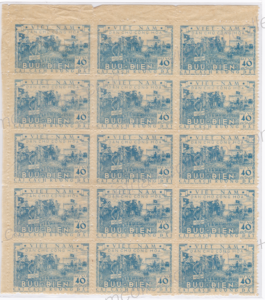
The mint service stamps of the first printing on thin paper are very hard to find as they basically had all been used up (i.e. cancelled or sold to stamp collectors) by the time the second printing on thicker paper was ordered. That is especially true of the 80 Dong value in mint condition as that represented the standard official letter rate.
Some perforation errors are known but are rare. Below is a pair of the 10D value that is imperforate at the bottom margin.
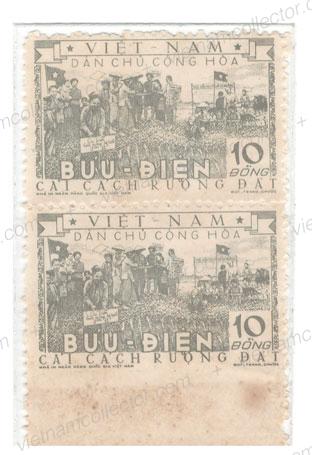
Postally used samples of these stamps are also very hard to find. In over 25 years of Vietnam stamp collection activity the editor has been unable to complete a single set! So Michel’s and Scott’s position that a used set should only be worth 1/3 or 2/3 of a mint set is utterly ridiculous. As a matter of fact, mint sets are quite common and are overvalued in both catalogues which price a mint set at roughly $100. Half of that would suffice given the easy availability in the market place. Here are the postally used stamps the editor has been able to collect so far: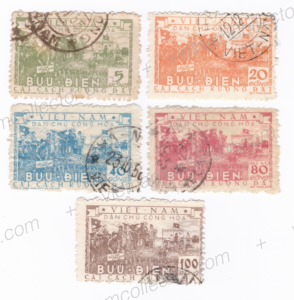
Cancelled to order specimen are quite easily available. They feature the standard “Hanoi” date canceler that is struck across four stamps so that each stamp only shows 25% of the cancel. The first 40D and 80D depicted is of the first print with thin paper and the second 40D and 80D is of the second print with thicker paper. The second 80D value shows the plate error of “NHA IN of the designer name partially missing. This is how a complete CTO set looks like:
Here is a block of four of the 80D service stamp on thin paper (CTO).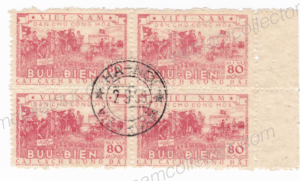
Errors on this issue appear to be rather rare. All the editor could find so far is a the 10D nominal which is imperforated on the right margin.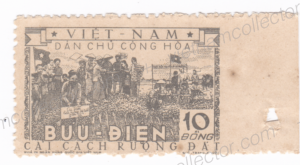
Once in an while fairly primitive counterfeits of the stamps issued in 1955/56 in honor of the Land Reform are being offered either by „reputable“ auction houses or on the internet. The original stamps were produced using the off-set printing method. The image of the counterfeits is much more unrefined and lacking in small details as compared to the originals.
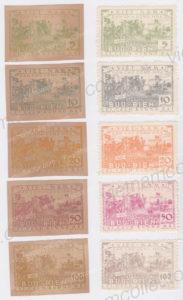 This is typical when a photo copier is being used to reproduce stamps. Also by using a copier the solid patches of color (e.g. parts of the top left and right box in these stamps) become blotchy showing small ‚white‘ spots devoid of color making the overall color look less uniform. Since the counterfeiters are well aware of their products deficiencies they are usually offered as „trial proofs“ that are imperforate. This avoids them having to use perforation irons (the rough perforation of many NVN stamps is harder to copy) and this claim also tries to cover up the fact that the counterfeits are printed on thicker carton like paper that is more or less tanned in color. The originals are printed on thin white paper. Attached is a scan showing the counterfeits on the left and the originals on the right. So do not get duped into buying these copies unless it is for a very nominal price and with the intent to demonstrate originals and fakes in your collection.
This is typical when a photo copier is being used to reproduce stamps. Also by using a copier the solid patches of color (e.g. parts of the top left and right box in these stamps) become blotchy showing small ‚white‘ spots devoid of color making the overall color look less uniform. Since the counterfeiters are well aware of their products deficiencies they are usually offered as „trial proofs“ that are imperforate. This avoids them having to use perforation irons (the rough perforation of many NVN stamps is harder to copy) and this claim also tries to cover up the fact that the counterfeits are printed on thicker carton like paper that is more or less tanned in color. The originals are printed on thin white paper. Attached is a scan showing the counterfeits on the left and the originals on the right. So do not get duped into buying these copies unless it is for a very nominal price and with the intent to demonstrate originals and fakes in your collection.
The editor has never seen a local letter with these stamps (other than official mail). That is probably as all of them were destroyed by the humid climate, decades of warfare or used to produce recycled paper.
International letters do exist but they are still pretty rare. Below is a letter mailed on January 16th, 1957 from an employee at the East German Embassy to East Germany. It shows a mixed franking totaling 605 Dong among which are the 5D and 20D Agrarian Reform stamps.
Mixed franking of the 20D and 50D Agrarian Reform stamps together with the 500D Production and Thrift stamp paying an overall postage of 600D on an international air mail letter sent in April of 1956 from Hanoi to East Germany.
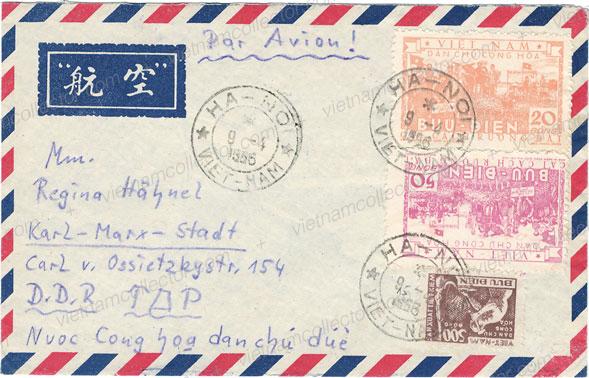
Mixed franking of the 20D Agrarian Reform stamps together with the 300D and 500D Railroad stamps paying an overall postage of 820D on an international air mail letter sent from Hanoi to Czechoslovakia in April of 1956. The standard surface letter rate at the time amounted to 300D and the air mail surcharge 270D for the first 5 grams of weight. So, this letter must have had a weight of 10g.
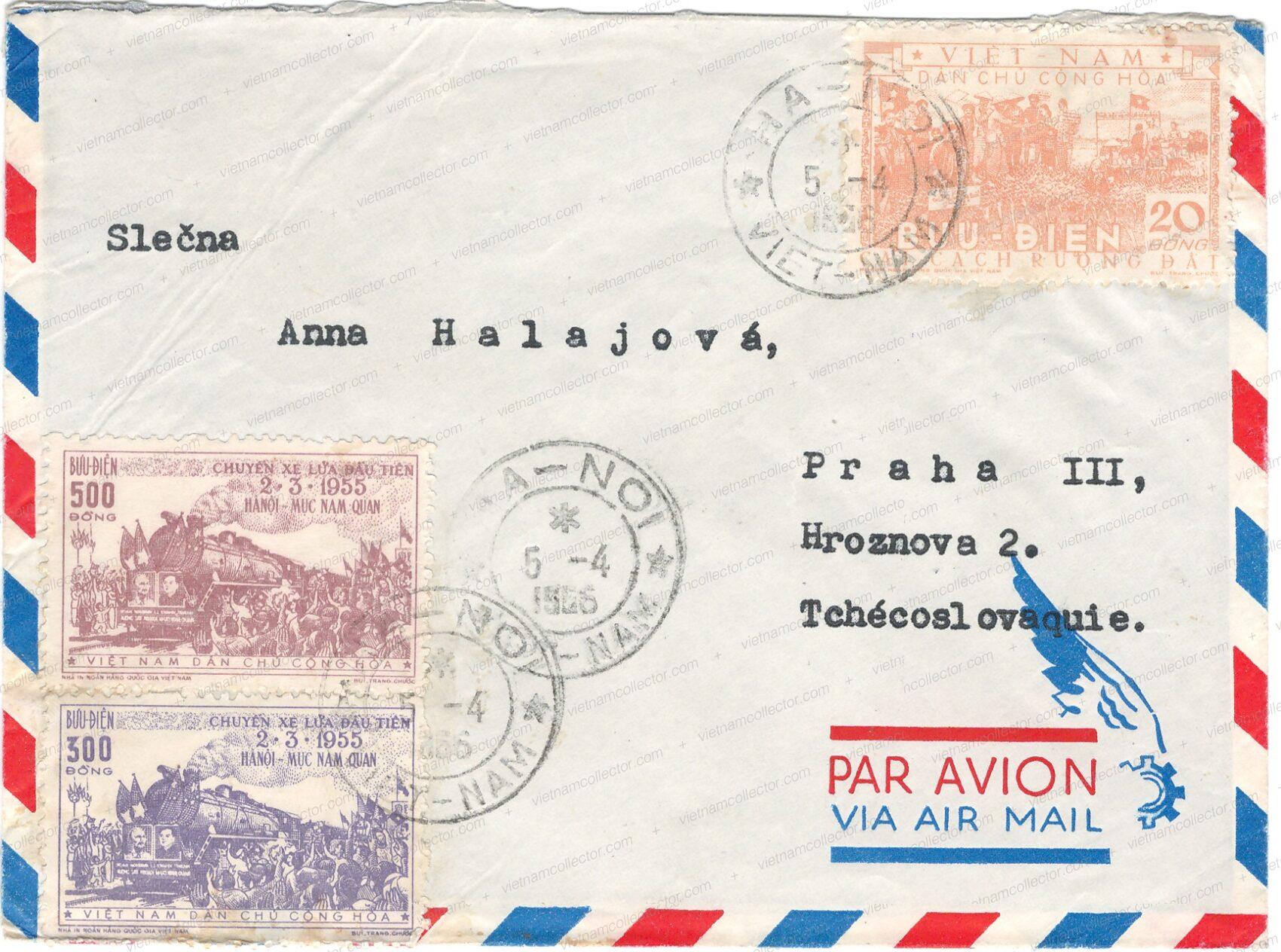
Mixed franking of the 20D Agrarian Reform stamps (2) together with the 300D and 500D Railroad stamps paying an overall postage of 840D on an international air mail letter sent from Hanoi to East Germany in March of 1956. The standard surface letter rate at the time amounted to 300D and the air mail surcharge 270D for the first 5 grams of weight. So, this letter must have been quite a bit heavier than 5g.
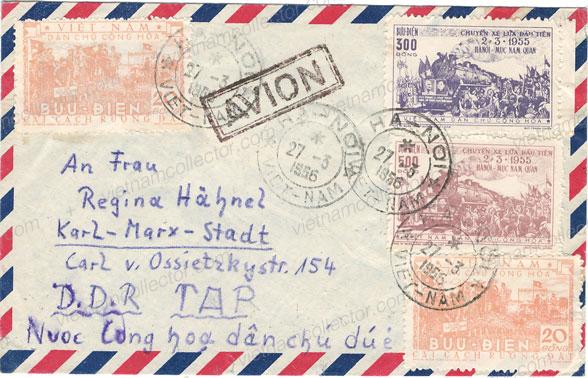
Mixed franking of the 20D Agrarian Reform stamps (2) together with the 300D and 500D Railroad stamps paying an overall postage of 840D on an international air mail letter sent from Hanoi to East Germany in April of 1956. The standard surface letter rate at the time amounted to 300D and the air mail surcharge 270D for the first 5 grams of weight. So, this letter must have been quite a bit heavier than 5g.
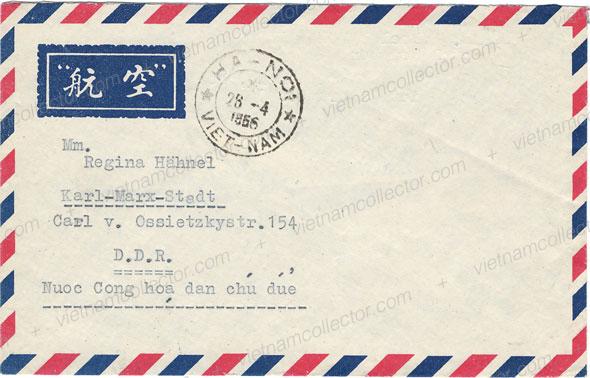
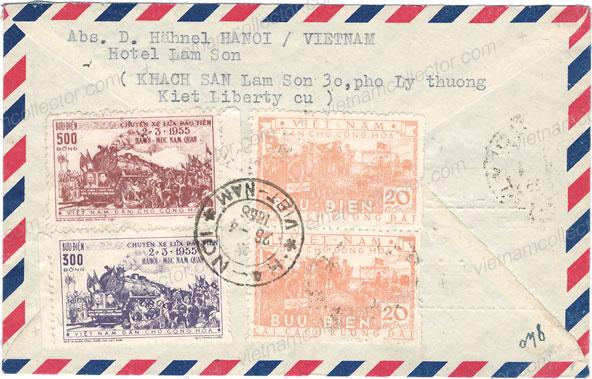
Mixed franking of the 20D (2) and 50D Agrarian Reform stamps together with stamps from the Production and Thrift and Dien Bien Phu sets paying the standard surface letter rate of 300D in February of 1955. Sent by a member of the East German Embassy to Dresden. The yellow rectangular hand stamp on the left 20D value is a Chinese censor mark that was applied when the letter traversed China en route to the Beijing-Moscow railway.
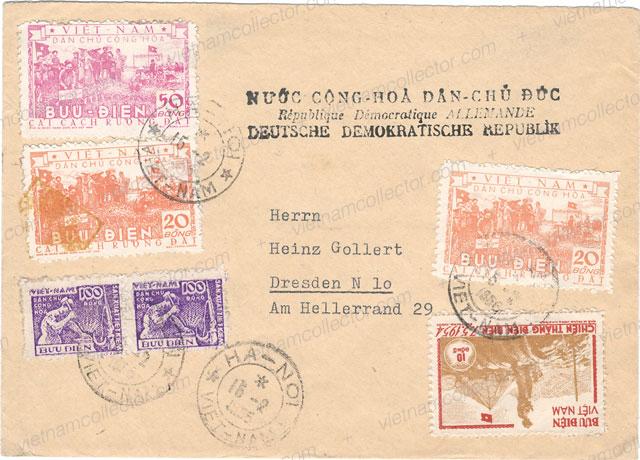
Mixed franking of the Agrarian Reform, Dien Bien Phu, HCH Birthday, Bai Thong Dam and Production and Thrift issues paying an overall tariff of 650D on an international air mail letter sent from Hanoi to Pilzen in Czechoslovakia in May of 1958. This rate was dictated by the March 15th, 1957 by the 300D surface letter rate plus 350D for air mail delivery.
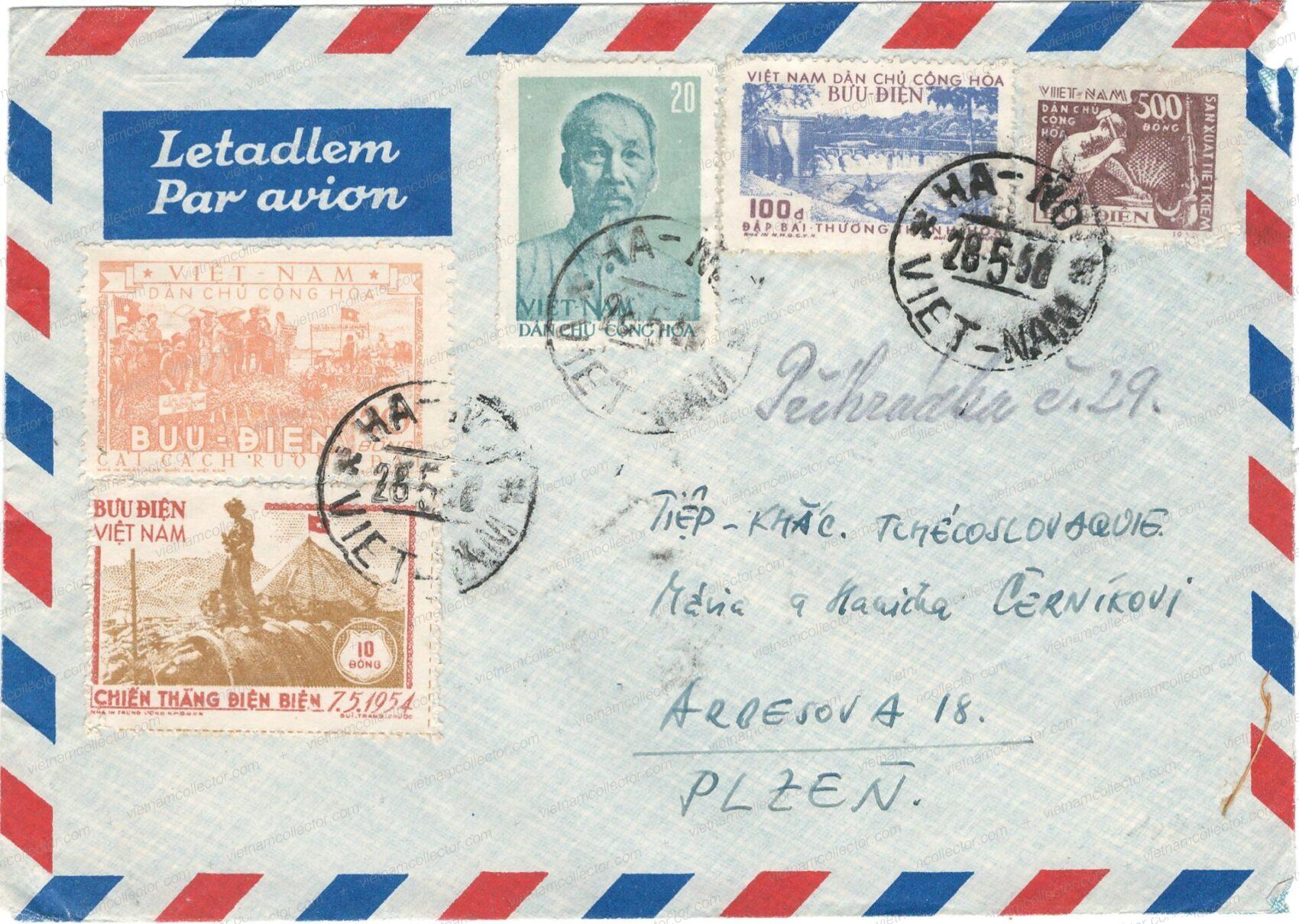
Mixed franking of the 20D and 50D Agrarian Reform stamps together with the 500D Railroad stamp paying the correct postage of 570D for an international air mail letters of up to 5g sent in April of 1956 from Hanoi to East Germany.
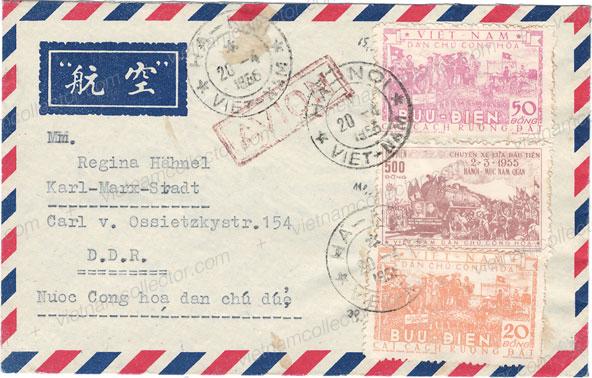
Mixed ranking of the Agrarian Reform, Dien Bien Phu and Production and Thrift sets paying an overall rate of 560D. This was made up of 300D for the standard surface mail rate plus 260D air mail surcharge for 5g weight. The letter was sent from Hanoi to Prague in Czechoslovakia in February of 1956.
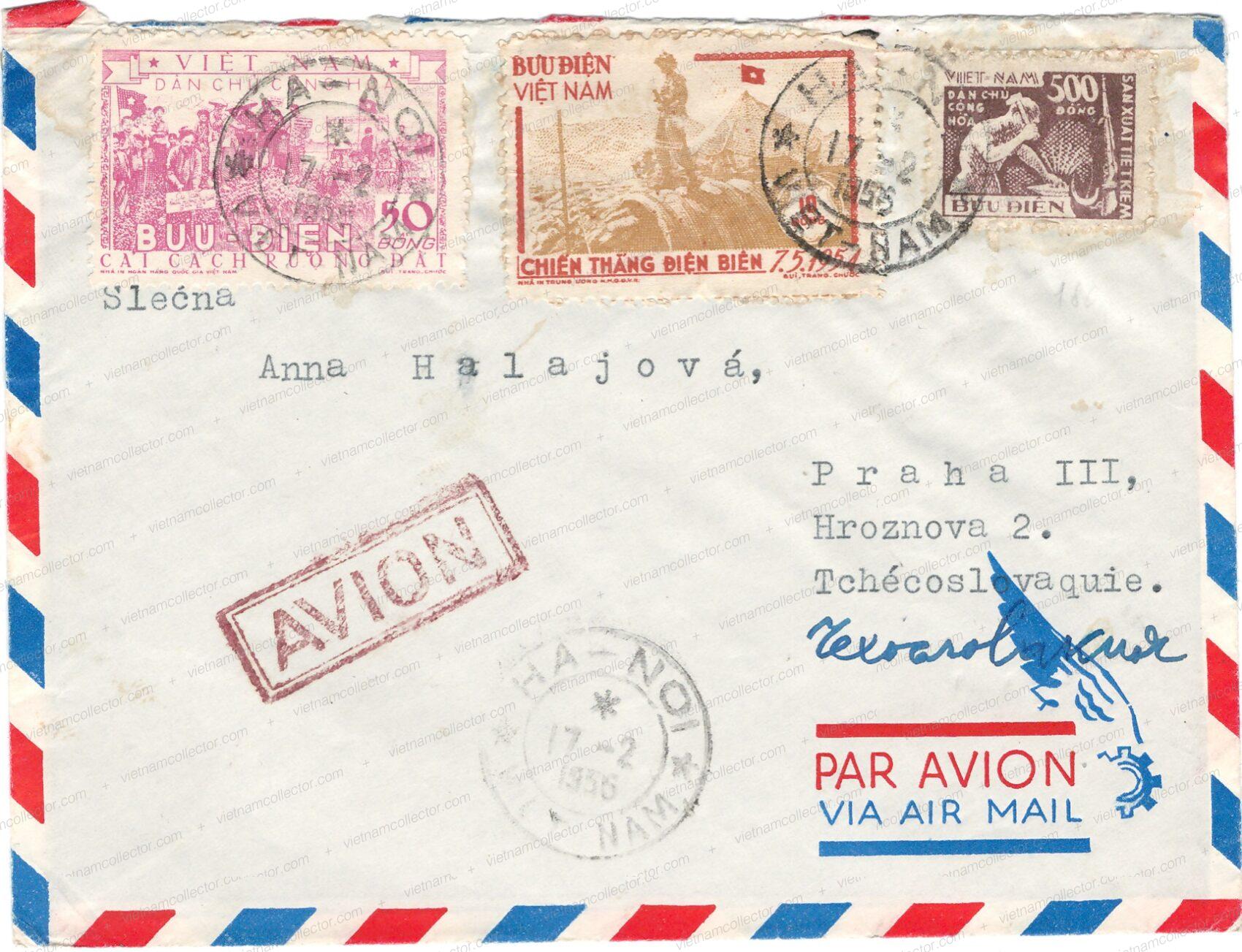
A letter from an East German Doctor staying in the Lam Son Hotel in Hanoi and addressed to his personal assistant in East Berlin in June of 1956. It is another mixed franking. This time of the brick red Michel Nr. 41aI, the 500D Railway and 50D Agrarian Reform stamp paying an overall postage of 570D which is the correct tariff for an air mail letter at that time.
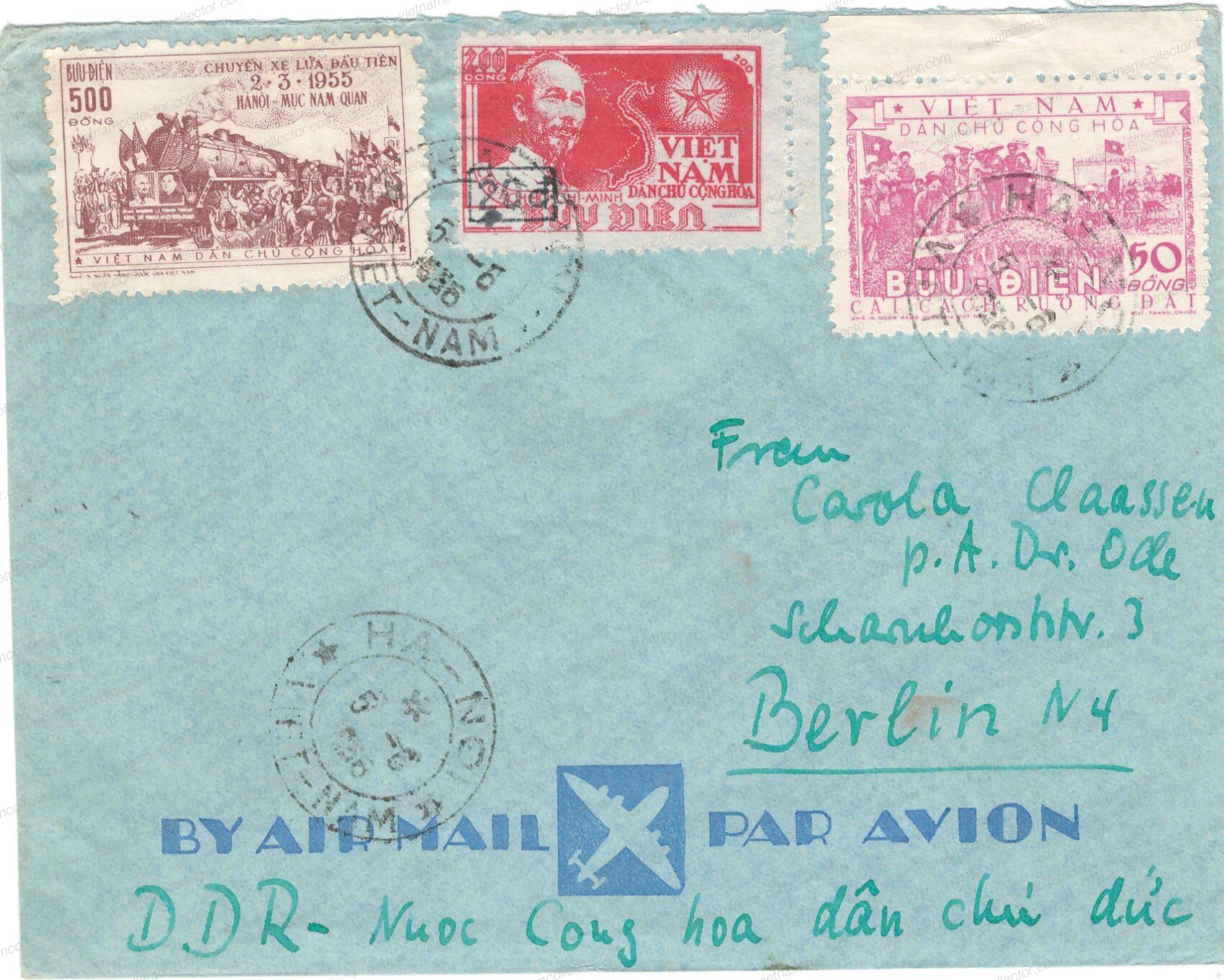
Official Mail bearing service stamps from North Vietnam is especially rare. This has to do with the fact that most official mail went from one Government office to another and hence ended up in the waster paper basket or in a Government archive. Archives would periodically be purged and all documents and letters in it destroyed. The same happened when Government archives were taken over by the enemy or destroyed by bombs. Surviving letters appear to come mainly from Eastern European collectors who had direct contact to high level North Vietnamese officials, who supplied the envelopes. Below is a letter (ex Gregor Schwirtz) from June 30, 1956. Schwirtz commented in his album “service letter from Hai-Duong, due to an increase in postage mixed franking with regular stamps, rare”. Indeed the letter carries one official stamp of 80 Dong (Michel Nr. D11 d) with the “Su Vu” inscription and four 10D stamps the Agrarian Reform series for a total postage of 120D. Prior to the 120D postage a standard official letter required 80D in postage, so, lower than the 100D standard civilian letter rate.
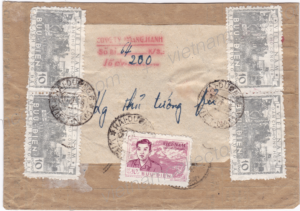
Below is an interesting franking on a letter to Bulgaria. It probably comes from an embassy employee as it carries three service stamps (40D thin paper and two 80D thicker paper of the Agrarian Reform set) along with other standard early NVN stamps. The overall franking amounts to 600 Dong. So, apparently foreign embassies were treated like Vietnamese Government offices and could be issued with service stamps that were normally not available to the general public. The date of the cancels is unreadable. Faint hand stamp in Cyrillic probably from the Bulgarian Embassy. Rare usage. Note that the left 80D stamp shows the plate error of “top right from surrounding VIETNAM open”.
Very rare official letter that was sent by the President of the Hanoi Appeals Court to the General Secretary of the Christian Democratic Union Party in East Germany Gerald Goetting. From 1960 until then end of the country in 1989 Goetting was the Assistant President of the highest political body in the country, the “Staatsrat”, which meant he was the second highest official in the land. The letter included a handwritten personal New Year’s greeting and was franked with a mixture of official and standard stamps. The postage was a mixture of the official 1kg Rice stamp together with four 40D official Agrarian Reform stamps (first printing, thin paper)and four standard 10D Dien Bien Phu stamps.
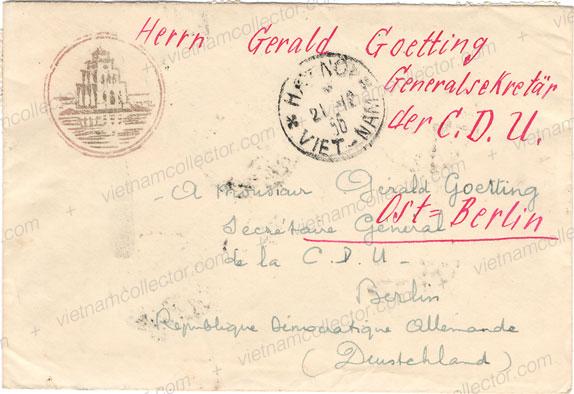
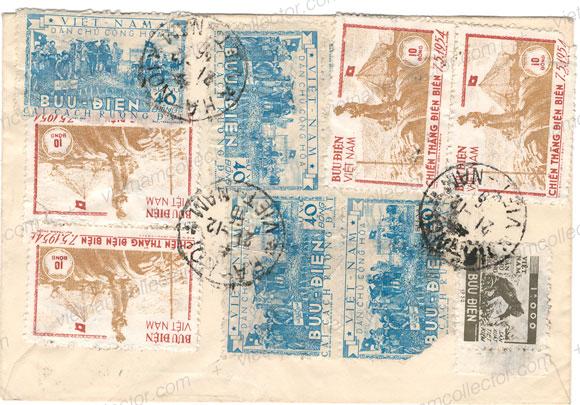
Here is a letter from March 16th, 1956 to East Germany carrying a mixed franking of 580 Dong. One of the values is the 50D Agrarian Reform issue.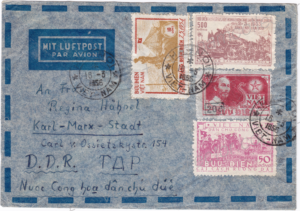
Below is another letter cancelled May 7th, 1955 with a mixed franking of 550 Dong to Brno in Czechoslovakia. It carries one specimen f the 50D Agrarian Reform stamp.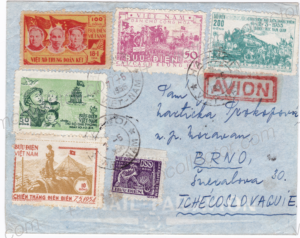
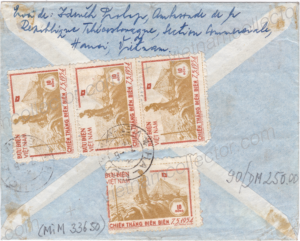
Very rare official letter sent in May of 1957 to the Red Cross in Geneva featuring two of the 1kg rice Production and Thrift service stamps plus one of the 80D Agrarian Reform service stamp (thick paper) in a mixed currency franking (kg rice and Dong) and mixed standard/official stamp franking. Note that the 80D stamp shows the plate error of “top frame open in center plus damaged T of VIETNAM”.
Letter mailed from Hanoi to China bearing the 100D Agrarian Reform plus the 200D Textile Mil stamp paying the surface letter rate of 300D. Note the square Chinese censor stamp on the reverse. Unusual golden decal of sail boat and a lake in front.
Here is another official letter sent by the Government export monopoly to the catalogue maker Ivert et Tellier in France from November 20th, 1959. It shows a spectacular mixed franking carrying one 20D,40D and six 80D service stamps (thick paper type) plus a regular stamp of the Liberation of Hanoi series (150D) for a total postage of 690 Dong. Very rare usage!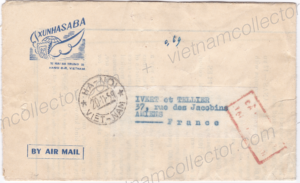
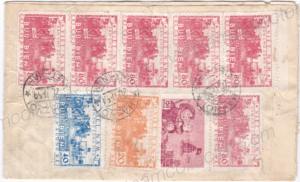
Below is a letter from September 21st, 1957 mailed to China. It carries a total postage of 535 Dong which appears high given that the standard letter rate to China at the time was only 400 Dong. One of the stamps is the 100D Agrarian Reform stamp. The letter may have been heavier than normal or may represent a philatelic franking (given the large variety of stamps on it) for a collector. At any rate it traveled through the mail and carries a Chinese censor stamp on the reverse.
Below is a very rare mailing by Radio “3W8AA” in Hanoi to a radio station (Radio HB9KB) in Switzerland. Most likely the letter contained the broadcasting dates and times of the station in Vietnam. The program was sent under the printed matter rate (see the Imprime’ or An Pham hand stamp on the front). The letter was mailed surface through the Transiberian Railway and routed through Canton (China), Beijing (China), Moscow (Russia) and finally East Berlin (East Germany). Early letters, in this case June 19th, 1956, to Western countries are very scarce, especially if they were mailed surface and as printed matter. Transit cancel from Canton (June 24th, 1956) on the reverse.
Below is a letter from April 7th, 1956 from hotel in Hanoi to the General Secretary of the National Committee of Korea and Vietnam in Berlin, East Germany. It is franked with a single stamp 500D railroad and a 20 Dong and 50 Dong stamp of the land reform issue for a total franking of 570 Dong. 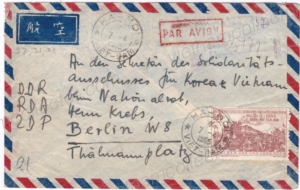
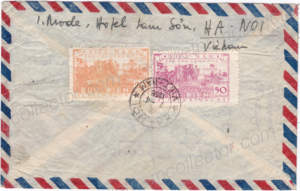
Mixed franking of the 40D official Agrarian Reform stamp on thick paper denominated in Old Dong (worth 4xu after March 1st, 1959) together with general purpose postage stamps (Agrarian Plants, Five Year Plan, National Savings and Fruits) for an overall postage of 13xu on a letter sent to East Germany in January of 1962. Slightly in excess of the required 12xi tariff.
Registration Nr. 100034

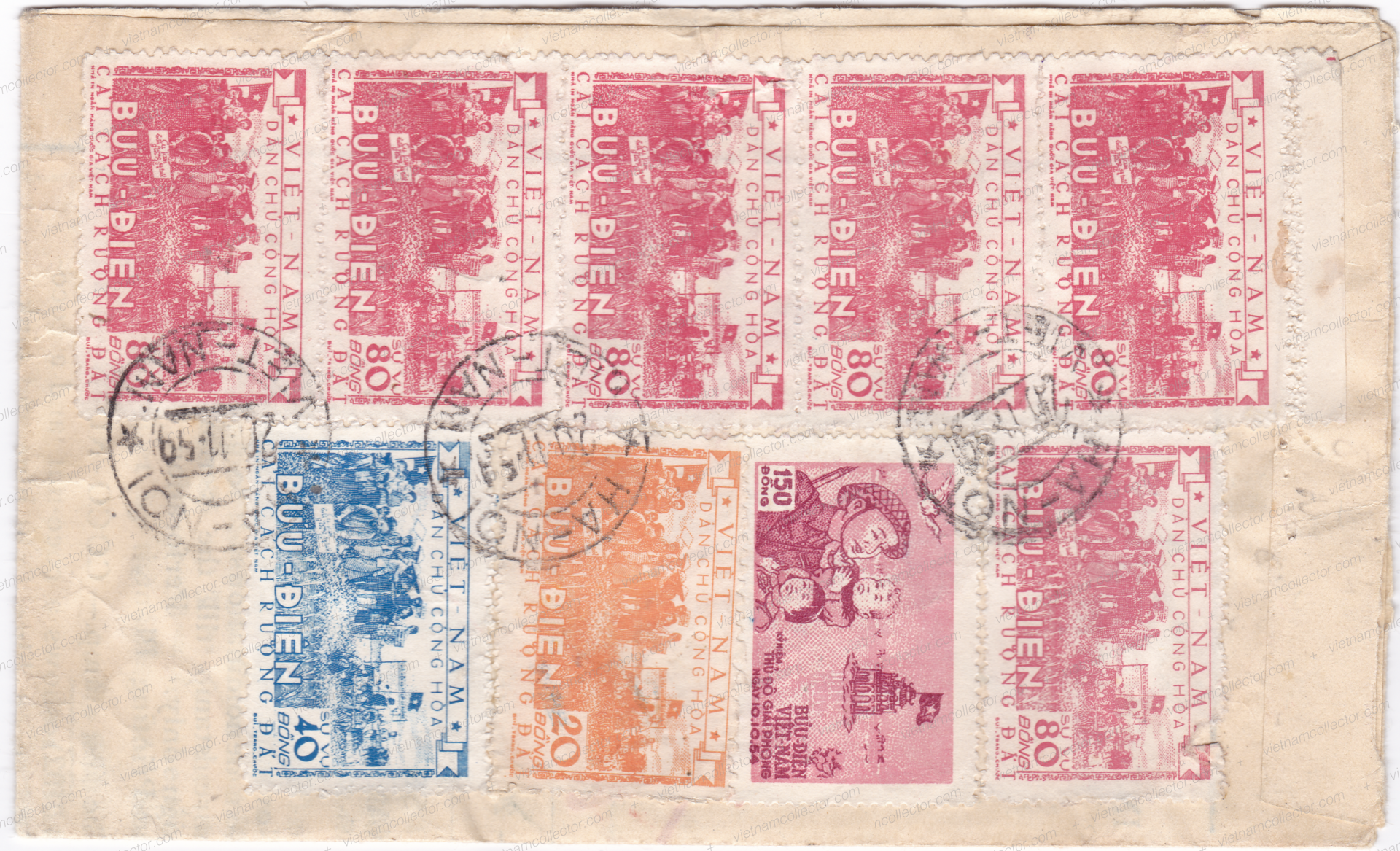
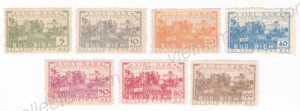
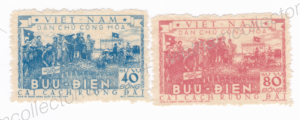
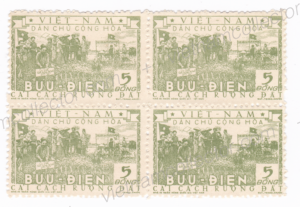
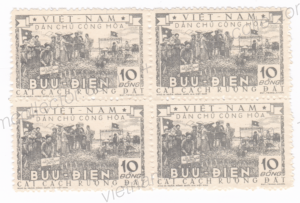
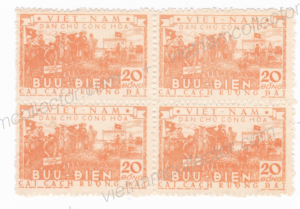
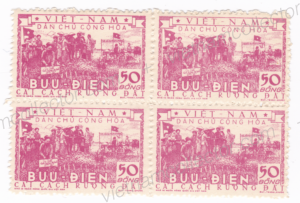
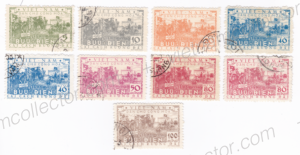
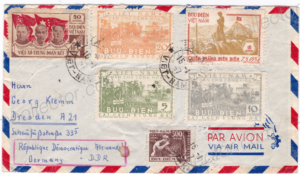
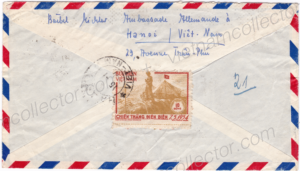
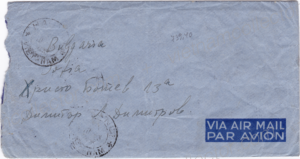
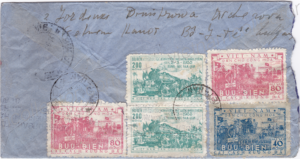
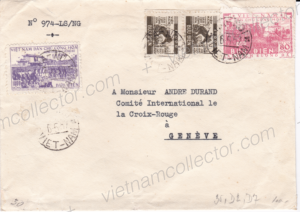
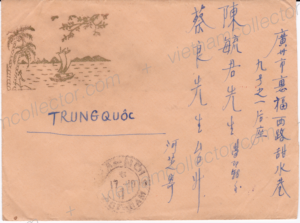
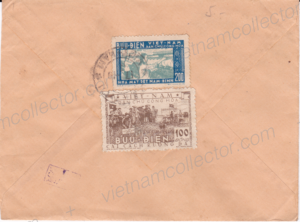
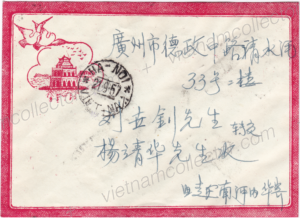
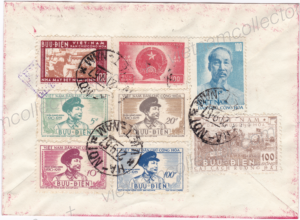
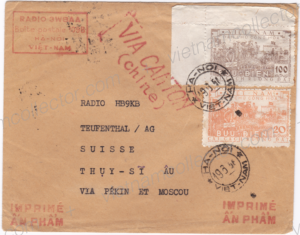
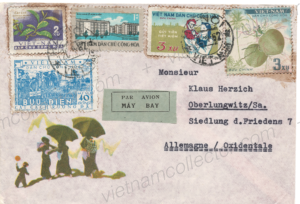
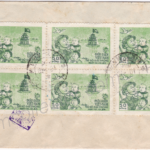
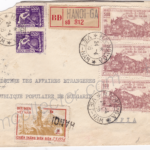


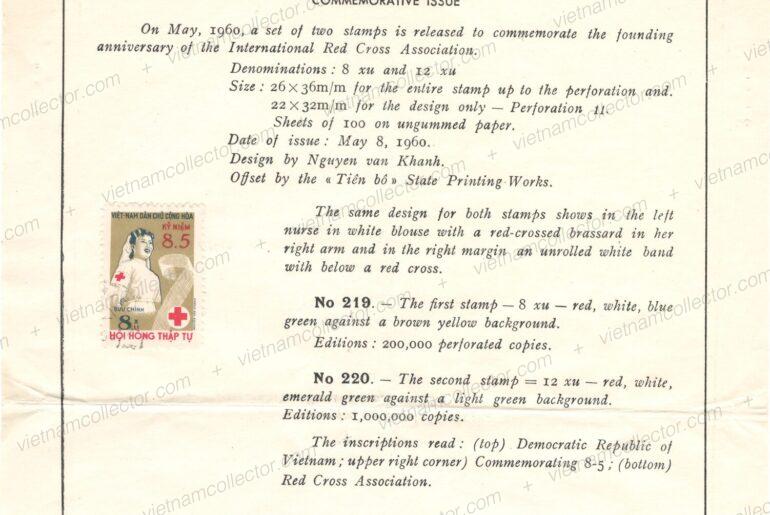
Comments are closed.